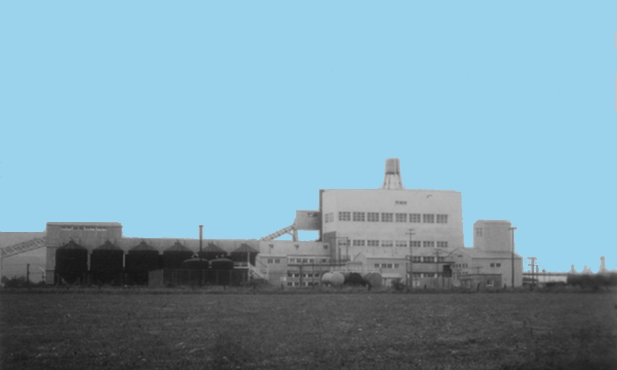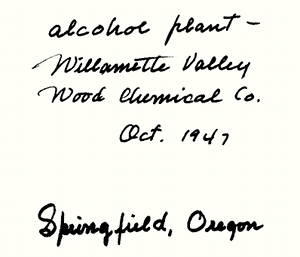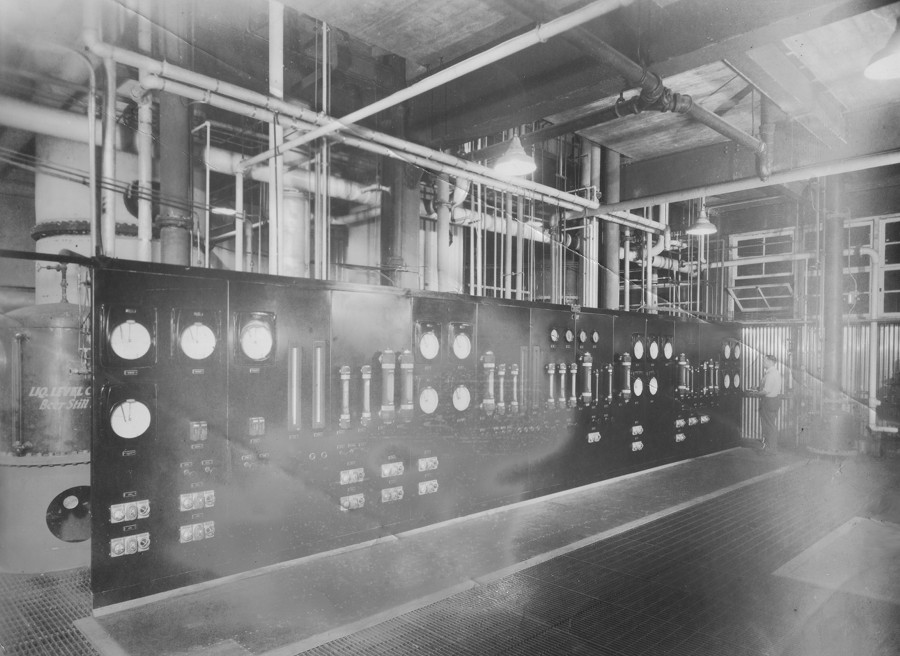Alcohol Plant
Willamette Valley Wood Chemical Company
Springfield, Oregon
1947
Sawdust into alcohol
The Willamette Valley Wood Chemical Company in Springfield, Oregon was organized in 1947 to operate a plant designed for making ethyl alcohol (C2H5OH) from Douglas-fir sawmill waste. The process, we were told, was perfected in Germany.
The Distillation Control Panel [shown at bottom, Bill Franson at work, far right, May 1947] controlled five stills, five stories high. The basic process: Mill waste steamed under pressure. The resulting liquid fermented into thin mud, 2% alcohol. This mud, or "beer", distilled to 190 proof ethyl alcohol. The process worked, but could not compete with alcohol from traditional sources.
We turned out ethyl alcohol in tankcar loads, pure enough to be used for any purpose, including medicinal uses. I believe the plant was built to provide rocket fuel and other military requirements. I was told that a plastic company in Chicago was buying our product. I don't know how much was made. We thought everybody would use our alcohol as fuel.
The government agents kept a strict watch on the product because of the possibilities of diversion to illegal uses. The high federal taxes on beverage alcohol did not apply, and the agents were alert to any possibility of diversion to the black market. I was told that we were making the alcohol for about 30 cents a gallon (not counting the government investment in the plant) and the tax on beverage alcohol was, I believe, about $9 a gallon then.
So every valve had a lock on it and the federal men had the keys. But the chemists were allowed to draw off some "laboratory samples" and we put some in our cars and drank a little, cut down with tap water. We thought it helped the cars and our morale. Probably not. My 1941 Plymouth did not feel any benefit, but one of the chemists claimed that his motorcycle ran better with a little ethyl alcohol in the gasoline

In late 1947 the federal subsidy was discontinued and the plant was shut down. It was eventually dismantled and scrapped in the 1950s, and all that was left was the huge pile of wood waste that had been put through the cyclone (the big blower that shot hot steam and acid through the sawdust to extract the edible material that the yeast could feed on). The inedible fiber was piled up and (several years after the plant was closed) was used by farmers as mulch.
I have long believed (lacking official proof) that the plant was shut down for two reasons. First, the agribusiness interests had a huge capacity for ethyl alcohol production and a powerful lobby. The second reason may have been the change of fuel used in the big rockets and missiles after World War II. Alcohol burned cleaner, with an exhaust almost transparent, while the petroleum-based fuels (similar to the fuels burned in jet aircraft) created a dense cloud of exhaust gases. But the jet fuels had more punch and thus increased the efficiency and range of the rocket engines.
© 1999 Wilfred R. Franson
Note by RWF —
My father does not mention here the accident when something went wrong in the new plant's alcohol distillation process, leading to a runaway pressure build-up that likely would have caused an explosion, destroying the entire plant and anything in the vicinity. My father, alone on duty in the middle of the night, spotted the pressure build-up and quickly visualized the consequences. Staying at the controls, he dumped the entire batch into the river, saving the plant. He later said that this created quite a head of beer on the river.
Alcohol Plant
Willamette Valley Wood Chemical Company
Springfield, Oregon
1. photo, center above:
Alcohol Plant exterior
October 1947
2. photo, below left:
VHF label for above
October 1947
3. photo, bottom:
Distillation Control Panel
Bill Franson at work, far right
May 1947
photos by Vera Howe Franson

More by Wilfred R. Franson
Aerospace at Troynovant
air and space travel and development
Fuel at Troynovant
wood, coal, & oil;
wind & water; nuclear & solar
The Eugene Post Office
Eugene, Oregon 1949-1956

| Troynovant, or Renewing Troy: | New | Contents | |||
| recurrent inspiration | Recent Updates | |||
|
www.Troynovant.com |
||||
|
Essays:
A-B
C-F
G-L
M-R
S-Z
|
||||
| Personae | Strata | Topography | |
|
|||